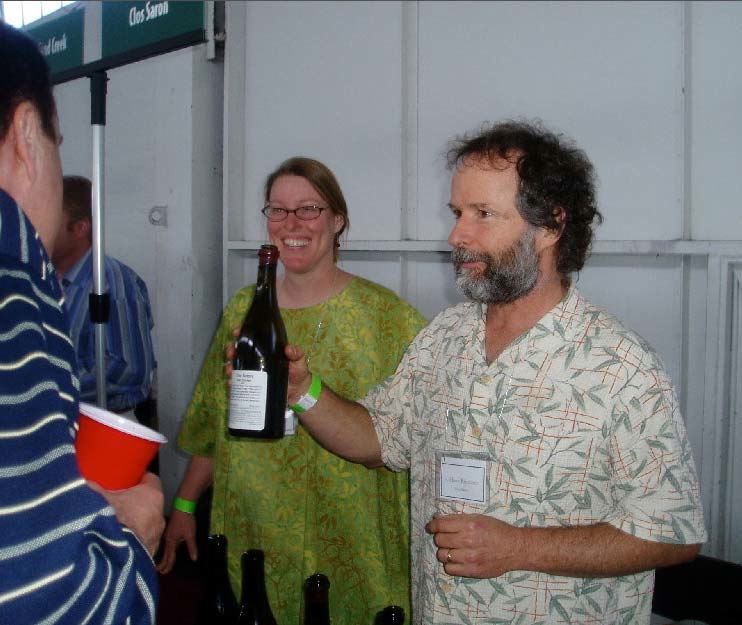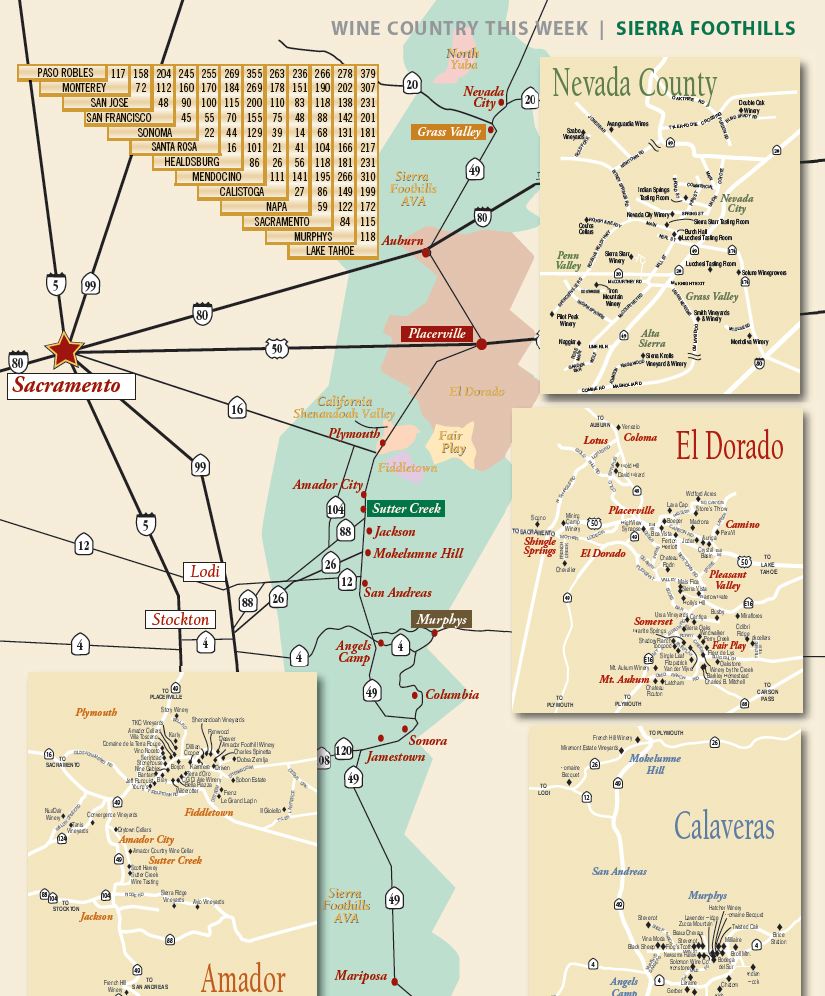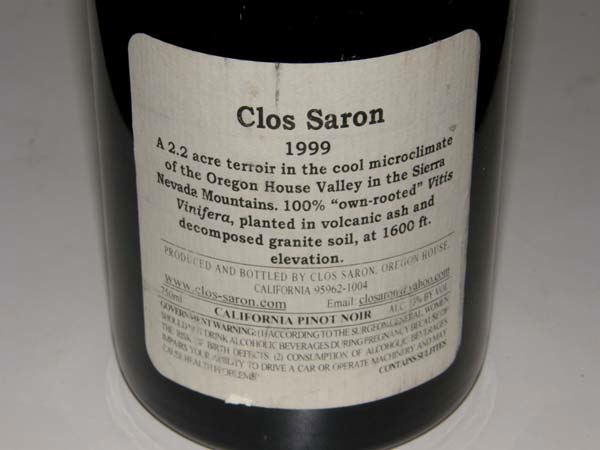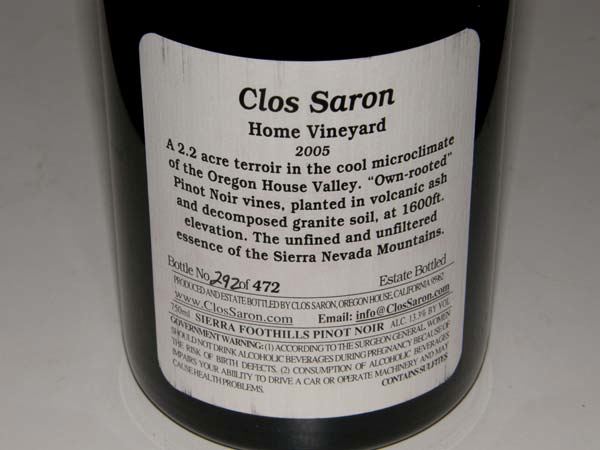Clos Saron: Distinct Pinot Noir from an Unlikely Region
Gideon Bienstock, an experienced winemaker, and his wife Saron Rice, have developed a small outpost for
Pinot Noir in the northern limits of the Sierra Foothills AVA of Northern California. Gideon is the winemaker for
the famed nearby Renaissance Vineyard & Winery and Saron is well-versed in viticulture. Together, they set
out over ten years ago to transcend all the preconceived notions about winegrowing possibilities in the Sierra
Foothills.
Located on the western slopes of the Sierra Nevada, the Sierra Foothills is a sprawling AVA of 2.6 million acres
that includes Amador, Calaveras, El Dorado, Mariposa, Nevada, Placer, Yuba and Tuolumne counties. There
are five sub-AVAs, including El Dorado, Fair Play, Fiddletown, North Yuba and Shenandoah Valley (refer to
map on page 8). The AVA is known for hot days and very cool nights with the extent of the diurnal range
dependent on the elevation. The soils are decomposed granite and finely crushed volcanic ash which provide
good drainage. Nutrients are sparse so vine roots are forced deep to seek out water and nourishment. The
well-over 100 wineries in the Sierra Foothills AVA have had proven success with warm climate varieties
including Zinfandel, Syrah, Petite Sirah, Cabernet Sauvignon and Sauvignon Blanc. The earliest vines were
planted during the California Gold Rush of the 1800s, and because of the relative isolation of the region from
other California wine growing areas, the vines have been protected from phylloxera and other insults. The
result is that the Sierra Foothills AVA contains some of California’s oldest producing vines.
Pinot Noir is not a variety that comes to mind when you think about the Sierra Foothills, but surprisingly, this
AVA has a history with Pinot Noir dating back to the 1880s. According to John Winthrop Haeger (North
American Pinot Noir), Eugene Hilgard of the University of California directed the planting of experimental
vineyards in the foothills of the Sierra Nevada near the town of Jackson in Amador County. More than 150
grape varieties including Pinot Noir were established at the Jackson Station. The project was abandoned in
1903 as the experiment proved untenable. Some surviving Pinot Noir vines were discovered in 1963 and
these so-called Jackson clones have remained of interest because they show some resistance to cold, having
adapted to the frigid winters in the Sierra Nevada. Despite that, the Jackson clones have never been widely
planted. The University of California at Davis classified the Jackson clones as UCD 1, UCD 9, UCD 16 and
UCD 29. According to Haeger, “The Jackson clones have the distinction of being the earliest documented
imports of Pinot Noir still under cultivation in North America, having unarguably been imported before 1890 -
and perhaps considerably earlier.”
Undaunted by the lack of historic success with Pinot Noir in the Sierra Foothills, Gideon and Saron (pictured
below at Pinot Days) have taken on the challenge. What they started, and what they have accomplished to
date, is a remarkable story. At Clos Saron, they only work with organic fruit and farm all their grapes, including
sourced grapes. They specialize in Pinot Noir and non traditional blends of other red and white varieties.
Annual production is around 800 cases, with Pinot Noir accounting for half the offerings and special cuvèes
making up the other half.


The heart of Clos Saron is the small Home Vineyard adjacent the family’s home and tiny winery in the Oregon
House Valley of Yuba County. The first half acre of Cabernet Sauvignon and Merlot vines were originally
planted on this gentle, north east facing forested slope in 1980. This old block was planted to 6’ x 8’ spacing
and these varieties rarely ripened at this site. In 1995, the vines were grafted to Pinot Noir and vine spacing
was increased in density to 3’ x 8’. In 1999, the vineyard was expanded to 2.5 acres after the densely wooded
property was cleared. These vines were spaced 3.5’ x 6’. The plantings include a potpourri of known and
unknown Pinot Noir clones, including all the popular Dijon clones, plus Pommard, old Wente, Swan and
suitcase clones. All vines are own rooted, cordon pruned with a four wire upright trellis. The soil is clay loam
on top of volcanic ash, decomposed granite and quartz. According to Gideon, “The soil is a mish-mash of
alluvial layers and fractured volcanic rocks.”
The vineyard is situated at 1,600 feet and is surrounded and protected by hills on three sides creating a cool
microclimate by Sierra Foothill standards. Typical summer daytime highs are in the 90° to 95° range and
nighttime lows 55° to 65°, with winter highs of 45° to 55° and lows of 25° to 35°. Spring frosts are an annual
threat and the 2010 vintage was a good example. Gideon told me, “2010 is the year from Hell, so far. Spring
was very wet (or was it a very late winter), with three waves of late frosts in the latter part of April, early May
and on May 21. The wetness and coolness of the season brought more mildew pressure than we have seen in
our twelve year history, although the Home Vineyard is virtually clean of mildew. The frosts did their usual
damage, but the three wave pattern was devastating with many vines lacking fruit completely. Old vines lost
arms, many young vines died back to their roots or completely perished. 50% of the total production was lost
with the estimated loss of Pinot Noir at about 80% to 90%.” The neighboring Texas Hill Road Vineyard, which
Gideon and Saron also farm, lost 100% of its Pinot Noir fruit. Gideon said he hopes to have one barrel of Pinot
Noir in 2010, from a total of 3.5 acres that they farm. Typical crop levels are extremely low with older vines
yielding about 1 ton per acre and younger vines less than half that much.
Farming is extreme organic with some biodynamic practices and an “overriding biodynamic farming philosophy
of establishing a self-sustaining ecosystem.” The Home Vineyard is not certified organic, but reflective of their
own common sense and conscience. No chemicals are used other than limited elemental sulfur. Cover crops
are used to help balance and enrich the top soil which is poor. There is limited mowing, leaving 25% of the
surface untouched to preserve the natural habitat for insects and a variety of plants. Watering is limited to what
is necessary to keep the vines alive. In 2010, the oldest block was never watered. Rabbits and chickens are
raised on the property, and their “production” is used to supplement bought compost.
During this past winter, preparation began for planting of 3 acres immediately north of the Home Vineyard. The
land has been cleared and fencing established. The spring was so wet they could not finish the soil
preparation in time for spring planting so they put the new vines in a nursery and slated them for a fall or winter
2011 planting. 90% of the cuttings in the nursery were eventually lost in the last round of frost on May 21, so
they will have to start over next year. The plan is for 0.5 acres of Pinot Noir, 1.5 acres of white varieties
including Voignier, Roussanne, and Sauvignon Blanc, and small amounts of Riesling and Syrah. Once the new
plantings are established, Clos Saron will be producing three or four different Pinot Noirs, each from a
distinctive microclimate and soil combination, all within 0.5 miles of their home.
Winemaking at Clos Saron is straightforward and simple with no acid corrections, no inoculations, no racking,
and no fining or filtration. The grapes are 100% de-stemmed. At fermentation, 35ppm SO2, but none is no SO2 is used post fermentation
making the bottled wines virtually sulfur free. According to Gideon, "When the wines are tested at a lab, they measure 0 to 8ppm of total SO2, comparable to what is created naturally by the fermentation process. The wines are basically sulfite-free and age on their concentration, balance, tannin, and acid rather than on the antiseptic properties of the sulfites. The absence of sulfite in the wines is the main cause for their very finicky nature, and why they go through various phases of weirdness, depending on then they are opened. This is also the reason for their relaxed, easy development in the glass with time, and in the bottle with years of aging."
Until 2006, Rousseau barrels only were used with 50% to 100%
new (not always by choice but restrained by the limited production). Since then they buy only once-used oak
barrels from other Pinot Noir producers so the oak barrels are one to five years old. Aging is typically on the
primary lees for 11 to 18 months, depending on the vintage. The wines are bottled manually by gravity direct
from barrel. Each bottle is hand numbered and wrapped in tissue.
One of the limits on winemaking choices at Clos Saron is the limited fruit quantity to work with. The Home
Vineyard can produce as little as one or two barrels per harvest. Several passes over 3 to 4 weeks are
typically required to harvest all the fruit, so before 2005, more extended cold soak was used as a means to stall
until more fruit could be harvested. Through the years, Gideon and Saron have become more cautious with
extraction and pick earlier. They still go through the vineyard numerous times and pick only ripe fruit, but no
longer wait for the hyped “physiological ripeness.” Their definition of ripeness has changed and although they
like to pick black fruit with browning seeds with a slight softness to the touch of the grapes, they no longer wait
for grapes to soften.
In tasting the vertical of Pinot Noirs reviewed in this article, I noticed a definite change beginning with the 2005
vintage when the Pinot Noirs began showing a more expressive fruit style with slightly more restrained oak and
noticeably less tannins. The site tends to produce vigorous tannins because of the lean soil and very low
yields.
The Clos Saron Pinot Noirs are unique in character. Gideon says, “I like to think that they offer a respectable
alternative for those palates that get overwhelmed and tired of the super alcoholic, super rich and super thick
Pinot Noirs. The Clos Saron wines are for those who keep tasting and following what is happening in their
glass past the first couple of sips and throughout dinner. The tannins are easily neutralized and harmonized by
the proper companions at the dinner table including Epoisses, Brie and Pond l’Eveque cheeses, grilled salmon,
sushi, duck, rabbit, pheasant and wild turkey.” I find the Clos Saron Pinot Noirs, dare I say, more “Burgundian,”
than many California Pinot Noirs, with their emphasis not on flashy fruit, but on secondary nuances of earth,
game, spice and minerality along with a healthy tannic structure that bodes well for aging. The wines remind
me of those from Nuits-Saint-Georges such as Clos de la Maréchale from Jacques-Frédéric Mugnier or Les
Vaucrains from Domaine Henri Gouges. Gideon describes his Home Vineyard Pinot Noir as follows:
“Structured, spicy, minerally and earthy, with a strong vintage variation in balance and expression. This terroir
produces long-lived Pinot Noirs by California standards, reaching maturity at 8 to 12 or more years in the
bottle.”
I recently tasted through a vertical of Clos Saron Pinot Noirs. These are connoisseurs' wines that are
something very special. Darker fruited with generous tannins that soften and integrate with time and a
welcoming balance of acidity, these are nuanced wines offering the drinker much more than a one-dimensional
fruit-driven experience that is offered by so many California Pinot Noir brethren. There is no over ripe fruit to
obscure the message of the Home Vineyard terroir. The wines have all aged beautifully and I don’t think I will
live long enough to see how far these wines can go. I have to take my hat off to Gideon and Saron, who toil in
relative obscurity, but have remained dedicated to their goals despite many challenges that would have easily
deterred the less committed.
The 1999 through 2001 vintages were simply labeled Clos Saron California Pinot Noir. In 2002 and 2003, the
young vines starting producing limited quantities of grapes and these grapes were combined with grapes from
the nearby Renaissance Vineyard for a blend labeled “Pinot Too.” Pinot Too proved to be fruitier and earlier
maturing than the Home Vineyard version of the same vintages. The older vine Pinot Noir became the “Home
Vineyard Sierra Foothills Pinot Noir. All production from the Home Vineyard was combined beginning with the
2004 vintage. A second Pinot Noir bottling, from the nearby Texas Hill Road Vineyard, was produced in 2005
and 2006, with the 2007, 2008 and 2009 vintages devastated by frost.
A few years ago I visited and tasted at Clos Saron. For those looking for a unique setting and an adventurous
trip, I highly recommend a visit (by appointment). The address is 9269 Collin House Rd, Oregon House,
California. The phone is 530-692-1080 and the website is www.clossaron.com. A few cases of each vintage
are held back so that very limited quantities of older vintages can be made available (1 to 3 bottles per
customer with some magnums). For example, a few bottles of the 2000 ($85) and 1999 ($95) vintages are
available at the winery. The regular price for Home Vineyard Pinot Noir is $45, ridiculously low considering the
scarcity and the effort that goes into producing this unique wine.
A few other wineries in the Sierra Foothills have released recent vintages of Pinot Noir including Albeno Monari
Vineyard & Winery, Deaver Vineyards, Easton Wines, and Ursa Vineyards. I have not sampled any Pinot Noir
from these producers so please give me your opinion if you have the opportunity to drink them.

1999 Clos Saron California Pinot Noir
13% alc., 58 cases, $45.
Inaugural vintage.
·
Very good color. Appealing aromas of black
raspberries, blackberries, brioche, earth and oak, becoming more fruity
over time in the glass. The wine is holding up beautifully with plenty of
juicy dark berry fruit, integrated soft dusty tannins, and a good acid lift on
the fruity finish. Reminds me of an aged Burgundy 1er. Still drank well
the following day from an opened and re-corked bottle. Could go for another 5
to 10 years. An exceptional older Pinot Noir.

2001 Clos Saron California Pinot Noir
13% alc., 28 cases, $45.
·
Deep reddish-purple color in the glass.
Dark berries and black cherries are the featured fruits with oak, smoke and loamy earth in the background. A
bit rugged and still sporting flamboyant tannins, this Pinot drinks more like a Cab. The fruit core is quite tasty,
and there is a good spark of acidity on the finish. This wine will benefit from the proper food accompaniment.
Good.
2002 Clos Saron Pinot Too California Pinot Noir
13% alc., 30 cases, $25. From young vines in the Home
Vineyard.
·
Moderate reddish-purple color in the glass. The biggest surprise in the lineup. Alluring scents of wild
berries, black plum sauce, brier and exotic woods. Tasty core of black raspberry fruit with an underpinning of
grilled and smoked meat. Still retaining moderate tannins but smooth and silky in the mouth. My only nit would
be a little sharpness on the finish as the brisk acidity surfaces, but this would be easily tempered with the
proper food. An impressive young vine wine that has held up nicely. Very good.
2003 Clos Saron Home Vineyard California Pinot Noir
13.3% alc., 31 cases, $45.
·
Moderate reddish-purple
color in the glass. The fruit plays second fiddle to the aromas and flavors of loamy earthy, smoke, tobacco and
ash. There is plenty of drying tannins and a bright acid spine. A rustic wine with plenty of heft and a prominent
smoky tone throughout. Decent.
2004 Clos Saron Home Vineyard California Pinot Noir
13.3% alc., 32 cases, $45.
·
Moderate reddish-purple
hue in the glass. Aromas of dark berries, crushed rock, Crayola and oak char. Delicious essence of fresh
crushed berries that is vivid and intense on the palate and persisting for what seems like a minute on the big
finish. Very soft in the mouth with melded tannins. An impressive effort. Very good.
2005 Clos Saron Home Vineyard California Pinot Noir
13.3% alc., 39
cases, $45.
·
Moderate reddish-purple color in the glass. This wine
pleases on every level. The aromas are reminiscent of a fresh berry tart
with some floral, mineral, and oak notes in the background. Incredibly
delicious core of crushed wild berries, currants and black cherries with a
hint of spice and cola. The savory, even exotic, fruit is bright and striking
and its taste lingers on the pleasing finish. There is a deft touch of oak and the
tannins never intrude on the experience. Still great the next day from a
previously opened and re-corked bottle. Trust me, you are going to love this
wine.


2006 Clos Saron Home Vineyard Sierra Foothills Pinot Noir
13.4% alc., 78 cases, $45.
·
Medium
garnet color in the glass. The nose needs some coaxing in the glass, eventually offering pleasing
aromas of blackberries and boysenberries, oak and baking spices. Striking assault of fruit on the mid
palate with a potpourri of dark berries, black cherries and cassis with hints of spice, cola and game.
Takes on more interest and intensity with time in the glass. A seamless wine with well-proportioned
tannins and acidity bringing the fruit to life. Definitely will improve over the next several years.

2007 Clos Saron Home Vineyard Sierra Foothills Pinot Noir
13.4%
alc., 82 cases, $45.
·
Moderate reddish-purple color in the glass.The nose
is very striking and the most flamboyant in this vertical tasting. Profuse
aromas of fresh berries, rose petals, and exotic spices are mesmerizing.
Intensely fruity with flavors of black raspberries, cassis, olallieberries,
Oolong tea, cola and unidentified exotic notes. This is one of those
wines that really makes you want to take another sip. Seamless and
harmonious in every way. You can drink this wine now for its hedonistic aromas
and flavors, but this is one you will want to dance with after more maturation in
the bottle. I was stoked over this Pinot.
2008 Clos Saron Home Vineyard Sierra Foothills Pinot Noir
13.5% alc., 70 cases, $45.
·
This is far too
young to drink now, but the potential is obvious. The nose is shy, offering demure cherry and berry fruit aromas
with noticeable oak. Darkly fruited with hints of smoked meat, earth and cola. Still closed with oak and tannins
swamping the fruit now. If you drink now, decant. This is a twenty year wine. Very good.
